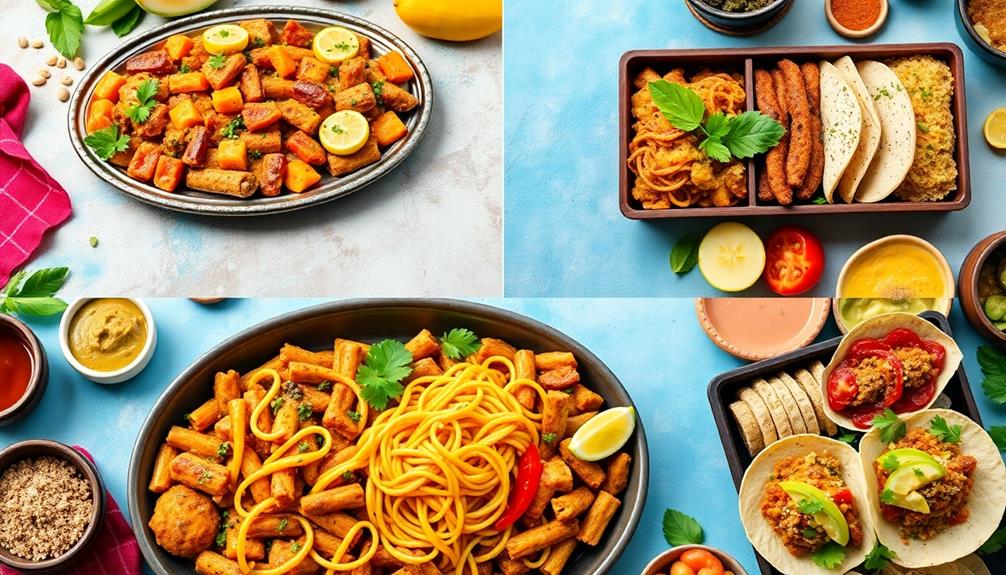Supertasters have a heightened sensitivity to flavors, especially bitter ones, which comes from having more taste buds—about 35 to 60 in a small area compared to the average 15 to 35. This increased density, influenced by the TAS2R38 gene, makes certain foods, like broccoli and kale, unappealing. Because of this, supertasters often prefer milder flavors, which can lead to selective eating habits and nutritional gaps. While they might enjoy complex flavors more, they can struggle socially due to their unique palates. You just might find the nuances of their experiences even more fascinating.
Key Takeaways
- Supertasters have a higher density of taste buds, leading to heightened sensitivity to flavors, especially bitterness.
- Approximately 25% of the population are supertasters, influenced by the TAS2R38 gene, particularly affecting bitter taste perception.
- Aversions to bitter foods like broccoli and kale can limit dietary variety and lead to nutrient deficiencies.
- Supertasters often use flavor masking techniques, such as adding salt or fat, to enhance the enjoyment of bitter foods.
- While supertasting may promote healthier choices, it can also hinder social dining experiences due to selective food preferences.
Definition of Supertasters
Supertasters are individuals who experience heightened sensitivity to flavors, especially bitterness, thanks to a greater number of taste buds on their tongues. You might find it fascinating that supertasters possess between 35 to 60 taste buds in a mere 6mm section of their tongue, compared to just 15 to 35 for average tasters.
This increased density of fungiform papillae allows them to detect flavors, including sweet, salty, sour, bitter, and umami, more acutely than others. Their unique palate might influence their reactions to certain dishes, such as the rich flavor of Red-Braised Pork Belly, which can be overwhelming for some.
Approximately 25% of the global population qualifies as supertasters, with a notable prevalence among women, particularly 35% of Caucasian women. The gene TAS2R38 plays a vital role in this phenomenon, influencing how these individuals perceive bitter compounds.
Because of their heightened sensitivity, supertasters often have distinct dietary preferences and may avoid foods they find overly bitter or strong.
The term "supertaster" emerged in the mid-1990s to define these unique individuals. By understanding what supertasters are, you can better appreciate how their enhanced flavor perception shapes their culinary experiences and choices.
Sensory Characteristics
As a supertaster, you experience heightened flavor sensitivity due to the dense concentration of taste buds on your tongue.
This means you can pick up on flavors that others might miss, especially bitterness, which often leads to aversions to certain foods.
For instance, the bold and spicy flavors found in dishes like Chicken Chettinad may be particularly intense for you, making the experience of enjoying such meals unique.
Your unique palate shapes the way you enjoy food, making you more selective about what you eat.
Heightened Flavor Sensitivity
The unique palate of supertasters reveals a world of heightened flavor sensitivity that can be both a gift and a challenge. With 35 to 60 taste buds in a 6mm section of your tongue, you experience flavors with extraordinary intensity. This increased density of fungiform papillae allows you to detect flavors that others might overlook, especially bitterness. You might find certain foods, like broccoli and Brussels sprouts, overwhelmingly intense due to this sensitivity.
Supertasters can identify all five primary flavors—sweet, salty, sour, bitter, and umami—but your heightened sensitivity can make sweet and spicy flavors feel overwhelming. Many supertasters prefer milder tastes, often describing their experience as a "prison sentence" due to the intensity of flavors.
Here's a quick comparison of taste sensitivity:
| Group | Taste Buds (per 6mm) | Flavor Sensitivity |
|---|---|---|
| Non-tasters | 15 or fewer | Low |
| Average tasters | 15 to 35 | Moderate |
| Supertasters | 35 to 60 | High |
Understanding your heightened sensitivity can help you navigate food choices more effectively.
Taste Bud Density
With a remarkable density of taste buds, supertasters experience flavors in a way that sets them apart from others. You might be surprised to learn that supertasters have a higher concentration of fungiform papillae on their tongues, boasting 35 to 60 taste buds in a mere 6mm section.
In contrast, average tasters have only 15 to 35, while non-tasters have 15 or fewer. This increased taste bud density enables supertasters to detect flavors, especially bitterness, much more intensely. This heightened sensitivity can influence their enjoyment of bold flavors found in dishes like Chilaquiles, which may present a more complex taste experience for them.
The heightened sensitivity is linked to the gene TAS2R38, which plays a significant role in how supertasters perceive bitter compounds in their food. This means that while you're enjoying a dish, a supertaster might find it overwhelmingly bitter, leading to strong aversions to certain foods, particularly those known for their bitterness, like some vegetables.
Interestingly, about 25% of the population are supertasters, with a notable prevalence among women and specific ethnic groups. Their unique sensory experiences shape their food preferences and can lead to both a refined palate and selective eating habits.
Bitter Taste Aversion
Supertasters experience a heightened aversion to bitter flavors, which can greatly influence their food choices and preferences. This sensitivity stems from a higher density of fungiform papillae on their tongues, meaning they've more taste buds—35 to 60 in a 6mm section—compared to average tasters.
The gene TAS2R38 plays an essential role in how you perceive bitter tastes, especially those found in cruciferous vegetables like broccoli and Brussels sprouts. If you're a supertaster, you might find these flavors overwhelmingly unpleasant, leading to a strong aversion. This aversion can extend to other complex flavors found in various cuisines, including the unique tastes of Ethiopian dishes like Yetimatim Fitfit, which may be challenging for supertasters to enjoy due to their tangy and spicy profiles.
Such aversions can considerably affect your vegetable intake, as lower consumption may lead to nutrient deficiencies over time. You may also find that sweet and fatty foods feel overwhelming, pushing you toward milder flavors and away from complex or bold culinary experiences.
This preference can further limit your food choices, especially in social dining situations where bitterness is common. Ultimately, your heightened sensitivity to bitter tastes shapes not just what you eat, but also how you enjoy and engage with food in various contexts. Understanding this aversion can help you navigate your palate more effectively.
Genetic Factors
Many people don't realize that genetics play a crucial role in determining taste sensitivity, particularly when it comes to supertasting. The TAS2R38 gene is a key player in this process, influencing how you perceive bitter compounds like phenylthiocarbamide (PTC) and 6-n-propylthiouracil (PROP). If you're a supertaster, you likely possess specific genetic variations within this gene that enhance your sensitivity to bitter flavors.
Notably, cultural influences, such as those found in Brazilian cuisine, can also shape how individuals experience and enjoy various flavors, adding another layer to the complexity of taste perception.
Around 25% of the global population are classified as supertasters, and this classification hinges greatly on genetic factors. Super-tasters usually have more fungiform papillae on their tongues, which means you might've between 35 to 60 taste buds in a 6mm section, compared to just 15 to 35 for average tasters. This abundance of taste buds contributes to your heightened sensitivity to bitter tastes.
Genetic testing can help identify whether you're a supertaster or a non-taster, providing valuable insights for personalized dietary recommendations. Understanding your unique genetic makeup can empower you to make informed choices about the foods you enjoy and those you may want to avoid.
Eating Habits
As a supertaster, you likely find yourself avoiding bitter foods like broccoli and kale, which can shape your eating habits considerably.
This aversion may lead you to seek out more palatable alternatives, such as Nettle and Potato Soup, which offers a nutritious blend without the bitterness of certain vegetables.
To make meals more enjoyable, you might rely on salt, fat, or sugar to mask those unpleasant flavors.
However, this preference can lead to nutritional gaps over time, affecting your overall health.
Bitter Food Aversion
Experiencing heightened sensitivity to bitterness, supertasters often develop a strong aversion to certain foods, particularly cruciferous vegetables like broccoli and kale. This aversion stems from the gene TAS2R38, which makes you more sensitive to bitter flavors. As a result, you might prefer sweeter or milder tastes, leading to selective eating habits and reduced vegetable intake.
Curiously, many supertasters may also find themselves enjoying milder foods like Horiatiko Psomi (Country Bread), which offers a rustic flavor profile without the bitterness of certain vegetables. To compensate for the bitterness of these foods, you may find yourself adding excessive salt, fat, or sugar. While this might make your meals more palatable, it can also create potential dietary imbalances and health risks over time.
Being a supertaster, which affects about 25% of the population, means you face unique challenges in maintaining a balanced diet. Avoiding bitter foods can lead to nutrient deficiencies, particularly in vitamins and minerals that are commonly found in vegetables. This can increase the risk of certain health issues, such as colon cancer, as you miss out on the protective benefits of these foods.
Understanding your aversion to bitter flavors can help you find ways to incorporate more nutrients into your diet while managing your taste preferences effectively.
Flavor Masking Techniques
Supertasters face unique challenges when it comes to their eating habits, particularly in dealing with bitter flavors. To avoid bitter vegetables like broccoli and kale, you often resort to flavor masking techniques. One effective method is adding salt, fat, or sugar to counteract those strong tastes. For instance, you might sprinkle salt on grapefruit or salads to make them more palatable.
Additionally, incorporating richer toppings, such as cheese or creamy dressings, can help balance out the bitterness of certain ingredients, making them more enjoyable. Exploring classic American dishes like a Loaded Baked Potato can also provide a comforting option with flavors that are easier to appreciate.
To enhance your enjoyment of bitter foods, you can explore creative cooking methods. Roasting vegetables or incorporating sweet sauces can help create a balanced flavor profile that you find appealing. Although bitterness isn't your favorite, you still recognize the nutritional benefits of these vegetables. That's why you employ flavor compensation strategies.
You may make dietary adjustments that prioritize milder, less intense flavors while ensuring you meet your nutritional needs. By embracing these techniques, you can enjoy a wider variety of foods without sacrificing taste.
Nutritional Implications
Steering your diet as a supertaster means you often miss out on a range of nutrient-rich foods, particularly bitter vegetables like broccoli and kale. Your heightened sensitivity to bitter tastes can lead to significant nutrient deficiencies over time, making it tough to get essential vitamins and minerals.
You might find yourself avoiding these bitter foods, opting instead for sweeter options, which can result in a less balanced diet. For example, enjoying dishes like braised beef in Barolo wine can provide a rich flavor without the bitterness that supertasters often avoid.
To counteract the bitterness, you may add salt, fat, or sugar to your meals, but this habit can lead to excessive salt consumption and unhealthy dietary adjustments. This preference for sweeter foods can further complicate your eating habits, often making you a picky eater.
Moreover, your avoidance of bitter vegetables may increase your risk of certain cancers, particularly colon cancer, due to a lower intake of beneficial vegetables.
It's vital to find ways to incorporate a variety of healthy foods into your diet. Exploring different cooking methods or flavors might help you overcome the aversion to bitter foods, ensuring you get the nutrients your body needs for peak health.
Nutritional Implications
One significant nutritional implication of being a supertaster is the tendency to avoid bitter vegetables like broccoli and kale. This heightened sensitivity to taste can lead to lower vegetable intake, resulting in potential nutrient deficiencies over time. You might gravitate toward sweeter foods, increasing your intake of sugars and fats, which can disrupt your overall dietary balance.
For instance, those who prefer sweeter flavors may miss out on the health benefits of incorporating diverse dishes such as Turkey Soup or other nutrient-rich meals into their diets. While you may not consume high-calorie foods overall, the preference for sweeter options can still pose health risks.
Additionally, supertasters often sprinkle extra salt on their meals to mask bitterness, leading to increased sodium intake. This habit can elevate your risk of heart disease. The avoidance of beneficial cruciferous vegetables may also raise your risk of colon cancer, as these foods are vital for gut health.
Moreover, your selective eating habits can have emotional implications, affecting your enjoyment of food and social interactions. By limiting your exposure to a diverse range of nutrients, you mightn't only miss out on essential vitamins and minerals but also face challenges in maintaining a balanced diet.
Understanding these nutritional implications can help you make more informed choices for your health.
Benefits of Supertasting
The benefits of supertasting can greatly enhance your culinary experiences and overall health. With heightened sensitivity to bitter flavors, you naturally gravitate away from sugary foods and fatty snacks, which often leads to a lower body mass index compared to non-tasters. This aversion can help you make healthier lifestyle choices, steering you toward more nutritious options.
Your ability to appreciate taste complexity means you can savor the subtle nuances in gourmet dishes that others might overlook. This leads to a greater appreciation of food quality, enriching your dining experiences and making meals more enjoyable.
As a supertaster, you're likely to prefer milder flavors, encouraging you to select fresher, wholesome ingredients over overly processed ones.
Additionally, your sensitivity often extends to alcohol and tobacco, making you less inclined to indulge in these bitter-tasting substances. This further supports your commitment to a healthier lifestyle.
Challenges Faced
While supertasting offers numerous advantages, it also comes with its own set of challenges. As a supertaster, you might find it difficult to enjoy a wide variety of healthy foods due to your aversion to bitter flavors. This can lead to picky eating habits, resulting in nutrient imbalances that affect your overall health.
Social eating situations can become tricky, too. Your specific food preferences may limit your enjoyment of shared meals, making it hard to try new dishes alongside friends or family. The avoidance of bitter vegetables, like broccoli and kale, can increase health risks, such as a higher likelihood of developing certain cancers from lower vegetable intake.
To mask the unpleasant bitterness, you might rely on high salt usage. This habit can pose potential health issues, including an elevated risk of heart disease due to excessive sodium consumption.
Additionally, the emotional implications of selective eating can hinder your social interactions, leading to feelings of isolation during communal dining experiences. Balancing your unique palate with health and social enjoyment can be a complex challenge that supertasters must navigate.
Testing Methods
Identifying supertasters involves several effective testing methods that can reveal your sensitivity to bitter flavors. One common approach is the PROP (6-n-propylthiouracil) sensitivity test. If you react strongly to this bitter compound, you're likely classified as a supertaster. This test helps pinpoint your ability to perceive bitterness, which is a vital aspect of supertasting.
At-home testing methods also provide insight. You can apply blue food dye to your tongue and count the visible fungiform papillae. If you find between 35 to 60 papillae in a 6mm section, that's a strong indicator of supertasting ability. In contrast, the average taster has about 15 to 35 taste buds in the same area, while non-tasters have 15 or fewer.
Additionally, PTC (phenylthiocarbamide) test strips can gauge bitterness sensitivity. You might discover that while 75% of the general population finds PTC bitter, supertasters react even more intensely.
Impact on Food Preferences
Understanding whether you're a supertaster not only reveals your sensitivity to flavors but also shapes your food preferences in significant ways. As a supertaster, you have a heightened sensitivity to bitter flavors, which often leads to an aversion to certain foods like broccoli and Brussels sprouts. This aversion can limit your dietary variety, making it challenging to enjoy a broader range of vegetables.
Approximately 25% of the population identifies as supertasters, and your preferences might skew towards sweeter or fattier foods to mask those bitter notes. While this can make meals more enjoyable, it can also result in an imbalanced nutrient intake over time.
Your heightened taste sensitivity extends to beverages, too; you may find yourself avoiding bitter drinks like IPAs or dark beers, opting instead for lighter options.
Additionally, in social eating situations, you might struggle to appreciate dishes that others rave about, leading to feelings of exclusion. Recognizing these patterns in your food preferences can help you navigate your diet more consciously, ensuring you still get the nutrients you need while accommodating your unique palate.
Frequently Asked Questions
What Is the Science Behind Super Tasters?
You can think of supertasters as individuals with heightened taste sensitivity. They perceive flavors differently, particularly bitterness, due to a genetic variation, making certain foods more intense and often leading to unique dietary preferences.
What Is the Evolutionary Reason for Supertasters?
Imagine you're foraging for wild berries. Your heightened taste sensitivity helps you detect bitterness, signaling danger. This evolutionary trait likely protected your ancestors from toxic foods, enhancing survival, while modern society's food variety lessens its necessity.
Which Flavor Are Supertasters Most Sensitive To?
You're most sensitive to bitter flavors as a supertaster. This heightened sensitivity often leads you to avoid foods like broccoli or certain drinks, as their intense bitterness can be overwhelming and unpleasant for your palate.
What Are the Disadvantages of Supertasters?
Exploring a culinary maze, you may find supertasting limits your food enjoyment. You dodge bitter vegetables, risk nutrient deficiencies, and miss out on diverse flavors, which can leave your palate yearning for more adventurous dining experiences.
Conclusion
In understanding supertasters, you're not just exploring unique palates; you're delving into a world where taste becomes an intricate tapestry of flavors and sensations. These individuals navigate their culinary landscapes with heightened sensitivity, revealing both delightful and formidable challenges. While their refined taste buds can lead to exquisite dining experiences, they might also encounter dietary dilemmas. Embracing this complexity, you'll appreciate the subtle nuances that shape their food preferences and the rich tapestry of human experience surrounding taste.









